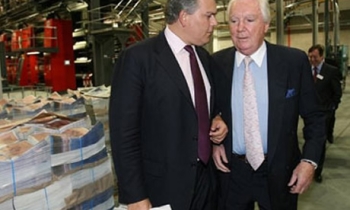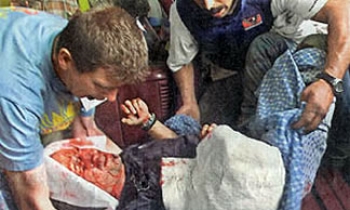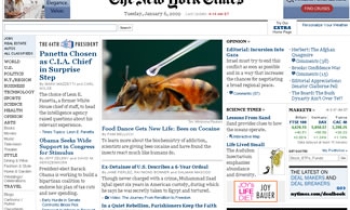CHICAGO This is the story of how one newspaper fought layoffs or buyouts, one half-day at a time.
In 2000, the Daily Herald in Chicago's northwestern and western suburbs was on top of the world. Illinois' third-largest daily was also its fastest growing. E&P had named it to its inaugural list of "10 That Do it Right." Revenues were the highest in its history, making Paddock Publishing Co. a $101 million business. "A year later, we were a $94 million company," Daily Herald President and CEO Douglas K. Ray recalls, "then a $92 million company the year after that, and the year after that we were still a $92 million company."
In 2000, the newspaper had enjoyed the third part of founder H.C. Paddock's famous pronouncement that appears every day on the paper's masthead: "Our aim: To fear God, tell the truth, and make money." Now it would come to appreciate the first two parts of the slogan.
The Illinois daily was hardly alone in its pain. Overall, newspaper industry advertising revenues fell from $48.7 billion in 2000 to an estimated $44.3 billion in 2001 -- a sudden 9.9% decrease.
The industrywide advertising collapse of early 2001 came with few warning signs, but the Daily Herald picked them up. Every January it runs a special help-wanted Sunday section that had been a blockbuster the past several years, but in 2001 it was a bust. "We could see the clouds coming in," Ray says, "and we knew without adjusting our cost base, we would be in serious trouble."
As a family-owned newspaper, the Daily Herald had more freedom to ride out industry cycles than publicly traded publishers. But family ownership also kept it from taking the obvious step: laying off employees.
The paper was "overstaffed" by the industry's thumbnail standard, the result of growing from a weekly to a community daily to a full-service newspaper reflected in its current marketing theme: "Big picture. Local focus."
"We have 300 full-time people in editorial," Ray notes, "which is a big investment that was built up over time." Across-the-board layoffs would simply violate the culture that the paper had fostered, he adds.
That idea is typical of family-owned newspapers, says Drew Mendoza, managing principal of the Marietta, Ga.-based Family Business Consulting Group. Family owners, he explains, "are almost hyper-aware" of the connection between publishing success and editorial. "They also tend to have a pronounced commitment to their communities. As a result, I think they would avoid layoffs like the plague. This is not a decision they are going to make lightly."
In the case of the Daily Herald, there was one more factor that led its executives to shun layoffs -- they didn't think it would make business sense. The paper serves a highly desirable piece of Chicagoland, one that attracts aggressive competition not only from the downtown papers, the Chicago Tribune and the Chicago Sun-Times, but from good nearby suburban dailies, such as the Northwest Herald out of Crystal Lake, and The Courier News in Elgin.
"In this market, we felt we had to move to a full-service model, and that's very expensive, as you can imagine," Ray says. "So with the culture and the growth model that had served us for so long, what you really cannot do is what other companies tend to do, and that's make across-the-board layoffs." Cutting into the staff, he adds, would cut into content, "and into the fabric of the paper."
George Harmon is an associate professor of journalism specializing in the newspaper business at Northwestern University's Medill School of Journalism and has served for the past few years on Paddock Publishing's board of directors. "We really think the key is local news coverage, that 'big picture, local focus.' We really believe that works," he says. "And you need people to do it."
There was one more complication for the Daily Herald, another big expense that could not be touched. "In the middle of all this, we made the most significant bet we'd ever made in this market," Ray says. The paper was building a new production plant with new presses -- a $50 million project that came with new and unavoidable expenses, such as the cost of training crews.
So what to do?
Still, cutbacks had to come somewhere, if not in staffing.
Reporting and business travel was sliced to the absolutely essential. A hiring freeze was imposed. While no one was laid off, people were moved around. The advertising department, for instance, had a "floater" whose job essentially was to step in when a salesperson went on vacation. Now the floater was assigned permanently to develop the Daily Herald's growing line of niche publications. Printing training that might ordinarily have been done off-site was held at the plant, with the old presses running simultaneously to ensure production.
But the biggest decision was to reduce the entire staff's work week -- and therefore, their pay -- by 5%. Employees were told to take a half-day off every two weeks, and overtime was strongly discouraged. It was a bombshell in the newsroom, but the impact was mitigated by management's openness, recalls Mike Comerford, the paper's senior business writer.
"It was scary, but there were assurances at the time," he says. "Assurances that we were going to come back, that we had managed to do it in the past. We started getting e-mails from the bosses as to how we were doing financially. They redoubled their effort to communicate with people about the financial condition of the company so there wasn't any adversarial misunderstanding."
The messages came at least once a month. "We were more open during the recession than we had ever been before," Ray says. "If you're going to ask people to sacrifice, you have to tell them why." And it was a sacrifice. Comerford, single at the time, both enjoyed the shorter schedule and hated it.
"You had time to go to a ball game," he says. "But at the same time, I feel very competitive with the Tribune and Sun-Times, and if someone else can work longer and harder at the story, that person has the advantage." On the business section, everyone was working harder, if not longer. With beat transfers and unfilled departures, the desk was down three people. Senior writer Comerford was drafted frequently to write briefs.
Reporters also began keeping track of the hours their colleagues were working. And the anxiety that layoffs might come anyway never disappeared among some reporters, Comerford adds. At one point, the newspaper stopped making contributions to employee 401(K) plans. The cutback was a financial squeeze, he says: "It's amazing what 5% of your income means. I've covered United Airlines, where those people are taking 30% pay cuts, and I just think, how do they do it?"
By 2004, regular working hours were restored, and in September of that year, the newspaper gave every employee a surprise bonus of $250, dropped off one Friday afternoon in envelopes on their desks.
Like any reporter, Comerford sometimes wonders about the long-term future of newspapers. But the Daily Herald strategy worked in the last recession. "They said that we were going to come back, and it did happen," he says. "We're hiring again."
Though the recession is behind it, the Herald continues to update employees frequently on its financial condition. This time, though, the news is good. "Quite frankly, we're doing very well now," Ray says. Advertising is up double digits over last year, except for automotive classified, which is down across the industry.
"We'll get back above $101 million this year," he says. "We'll probably hit $105 million, and maybe more."
Mark Fitzgerald (mfitzgerald@editorandpublisher.com) is E&P's editor-at-large.









